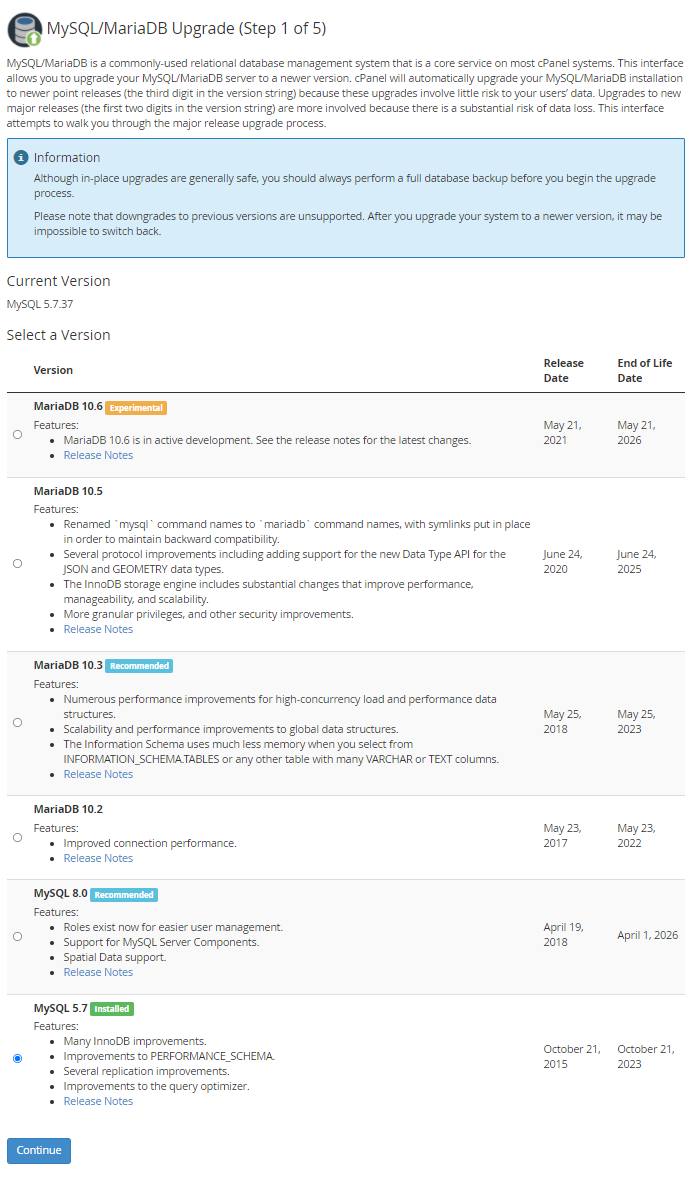
- Bluehost upgrade mysql version how to#
- Bluehost upgrade mysql version install#
- Bluehost upgrade mysql version generator#
To make the necessary changes, go to the "Software" section in the "Advanced" tab. Setting the appropriate version of the PHP language and adjusting its configuration is crucial and can significantly affect the installation process. For the Droopler installation to work correctly, it's safest to assign all permissions by selecting the "ALL PRIVILEGES'' option. In the third step, you need to assign the user permissions to your database.
Bluehost upgrade mysql version generator#
You can generate the password using the Password Generator located in the form. In the next step, you need to define the database users (at least one) and their passwords. The full database name will consist of a prefix (usually associated with the account id) and a second part/name defined by you. It can be any name but in our example, we’ll use the most intuitive one - droopler. In the first step, you need to define the database name. You'll be redirected to the database wizard page. To do this, click on the "MySQL Database Wizard" in the "Databases" section. Database configurationįirst, you need to create a new database. To configure your hosting, after logging in to the account using the login form, go to the "Advanced" tab, where you'll find all the necessary functions: 1. But before you start, you need to get familiar with the requirements for the system on which you want to run Droopler.
Bluehost upgrade mysql version install#
This stage is necessary because, without it, it won't be possible to install Droopler.
Bluehost upgrade mysql version how to#
We will show you how to install Droopler, the Drupal distribution, using the basic shared hosting offer (Basic Web Hosting).įirst, you need to configure the database and PHP. The company's offer includes a wide range of services. That kind of thing usually costs hundreds if not thousands of dollars from other providers.Bluehost is among the 20 largest hosting companies in the world, handling over 2 million domains. insane value for $20/mo that gets you globally cached edge nodes and global dns and they're also betaing integrated load balancing. In any case I would still heavily recommend cloudflare. If you start with Amazon or Rackspace or heroku or digital ocean or linode or Google app engine, scaling it up later becomes easier. By then hopefully you won't be the only developer :)īeyond that, you're talking about the next Google or Facebook and I dunno anything about that kind of scale so I'll just stfu now.īluehost can do the first two kinds (shared and one dedicated server) but it's hard to make it scale up much beyond that. Up from that, you'll have to have a team manage dynamic instances and scaling across the world as usage goes up or down any given moment.

One step up from that would be several such servers load balanced so that visitors will be distributed amongst them, but you'll have to either have separate database servers (also scaled) or else set up some sort of syncing system. These days they're rarely bare metal anymore, but you should get what you paid for. One step up from that would be a dedicated server with a certain amount of designated resources set aside for you specifically. The lower end bluehost plans are on shared servers, which means your users are competing for system resources with other websites' visitors on the same box. It depends on the kind of scale you want.


 0 kommentar(er)
0 kommentar(er)
